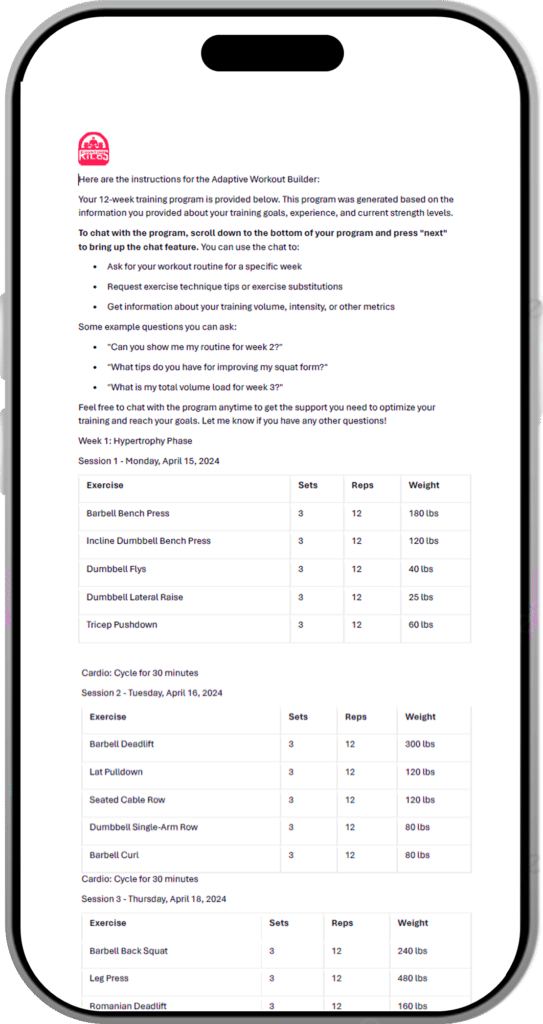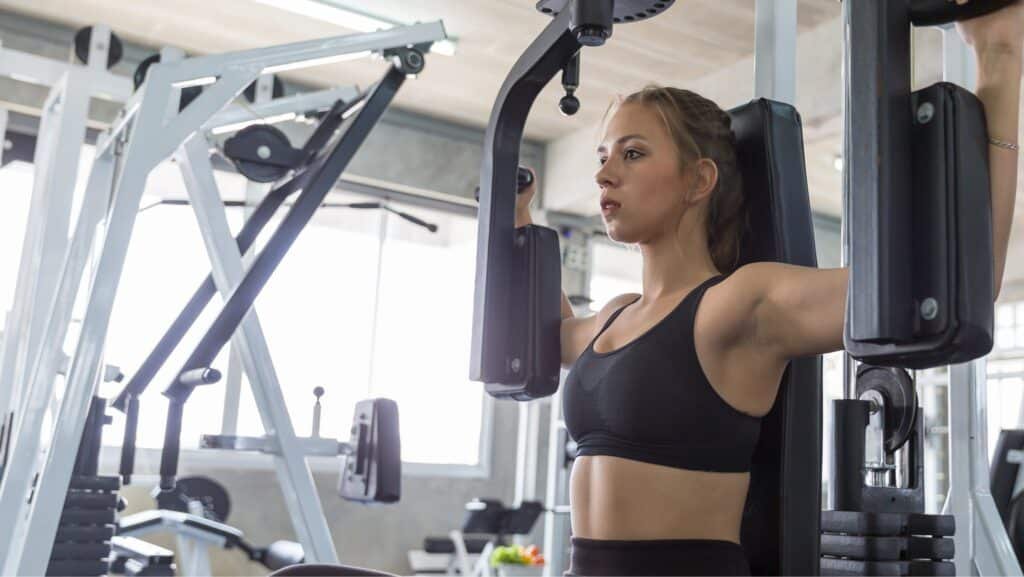In the pantheon of chest exercises, the bench press may reign supreme, but allow me to introduce you to the unsung hero of pectoral development: the chest fly machine. This mechanical marvel is the Chest Day MVP of chest exercises – versatile, reliable, and far less likely to leave you with a barbell-shaped imprint on your forehead. So, let’s talk about the science and art of the perfect chest fly, and discover why this machine deserves a spot in the hall of fame of muscle-building equipment.
Key Takeaways:
- The chest fly machine primarily targets the pectoralis major, with secondary engagement of the anterior deltoids and biceps.
- Proper form is crucial for maximizing benefits and minimizing injury risk.
- Various machine types and alternative exercises can be incorporated for a well-rounded chest workout.
- Progressive overload and consistent tracking are essential for continuous improvement.
- Proper nutrition and recovery strategies complement the physical training for optimal chest development.
Table of contents
- Introduction to the Chest Fly Machine
- Proper Form and Technique
- Variations and Programming
- STOP WASTING YOUR TIME WITHOUT A PLAN
- Progression and Performance Metrics
- Benefits for Different Fitness Levels
- Safety Considerations and Injury Prevention
- Nutrition and Recovery for Optimal Chest Development
- Conclusion

Introduction to the Chest Fly Machine
Ah, the chest fly machine – that contraption in the gym that looks like it could double as a medieval torture device but is actually your ticket to a chiseled chest. But what exactly is this mechanical marvel?
What is a Chest Fly Machine?
The chest fly machine, my friends, is a piece of resistance equipment designed to isolate and strengthen the pectoral muscles. It’s like a hug machine, except instead of giving love, it’s giving you gains. There are primarily two types of these bad boys:
- Handle-based machines: These feature two movable arms with handles that you grasp and bring together in front of your chest.
- Forearm pad-based machines: These have pads that your forearms rest on as you perform the movement.
The history of this machine is about as interesting as watching paint dry, but let’s just say it evolved from the need to isolate chest muscles more effectively than free weights could offer. It’s like the gym equipment equivalent of growing opposable thumbs – a game-changer in our fitness evolution.

Target Muscles and Benefits
Now, let’s talk about what this machine is actually doing for you, besides making you look like you’re trying to crush an invisible watermelon with your pecs.
The primary muscle targeted is the pectoralis major – that’s the big, meaty part of your chest that you flex when you’re trying to impress someone at the beach. But it’s not a solo act. The supporting cast includes:
- Anterior deltoids (front of the shoulders)
- Biceps (they’re just along for the ride, really)
The advantages of the chest fly machine are numerous:
- Muscle isolation: It’s like putting your pecs in a spotlight. They have nowhere to hide and no choice but to work.
- Hypertrophy: Fancy word for muscle growth. The controlled movement allows for constant tension, which is great for building mass.
- Safety: Compared to free weights, there’s less risk of dropping a dumbbell on your face. Trust me, that’s a win.
- Consistency: The fixed movement pattern ensures you’re hitting the target muscles every single rep.
Proper Form and Technique
Alright, now that we know what we’re dealing with, let’s talk about how to use this contraption without looking like a fish out of water.
Setting Up the Machine
First things first, you need to set this thing up properly. It’s not rocket science, but get it wrong, and you might as well be trying to build your chest by eating chicken breasts.
- Seat height: Adjust it so that the handles or pads align with your mid-chest level. You want to be hitting those pecs dead center, not giving yourself an unintentional neck workout.
- Back support: Make sure your back is firmly against the pad. This isn’t the time to practice your slouching skills.
- Weight selection: Start light, especially if you’re new to this. Your ego might want to max out the stack, but your muscles (and potentially your medical insurance) will thank you for being sensible.
Executing the Movement
Now for the main event. Here’s how to perform the chest fly like a pro:
- Starting position: Grab the handles or rest your forearms on the pads with your arms extended out to your sides. Think “I’m king of the world!” from Titanic, but seated and less dramatic.
- The fly: Bring your arms together in front of your chest in a controlled motion. Imagine you’re hugging a giant redwood tree – slow and steady.
- Peak contraction: At the point where your arms are closest together, give those pecs a little extra squeeze. It’s like giving them a pep talk.
- Return: Slowly let your arms return to the starting position. Control is key here – we’re not trying to fan ourselves.
- Breathing: Exhale as you bring your arms together, inhale as you return to the start. It’s not just lifting; it’s a zen experience.
Common Form Mistakes to Avoid
Even with a machine, there’s plenty of room for error. Here are some no-nos to watch out for:
- Using your triceps to push the weight instead of your chest. Your triceps aren’t invited to this pec party.
- Leaning forward to generate momentum. The machine isn’t a rocking chair.
- Relying on upper body leverage. Your shoulders should not be doing your chest’s job.
- Moving too quickly or using jerky motions. This isn’t a race, and you’re not trying to swat flies.
Variations and Programming
Variety is the spice of life, and it’s also the key to continued gains. Let’s spice up your chest routine.
Machine Variations
Not all chest fly machines are created equal. Here’s a rundown of the main types:
- Handle-based machines: These allow for a more natural grip and potentially a greater range of motion.
- Forearm pad-based machines: These take grip strength out of the equation, allowing for even greater isolation of the chest.
- Seated vs. lying machines: The seated version is more common, but some gyms have a lying version that mimics the dumbbell fly position.
Alternative Exercises
While the chest fly machine is great, it’s not the only player in the game. Here are some alternatives to keep things interesting:
- Cable chest flyes: Like the machine, but with more freedom of movement. It’s the free-range chicken of chest exercises.
- Dumbbell flyes: The OG chest fly. Requires more stabilization and offers a greater range of motion.
- Resistance band flyes: Great for home workouts or when you want to feel like you’re in a giant rubber band ball.
| Exercise | Pros | Cons |
|---|---|---|
| Machine Chest Fly | Consistent resistance, safer for beginners | Fixed movement pattern |
| Cable Chest Fly | Greater range of motion, variable resistance | Requires more coordination |
| Dumbbell Fly | Engages stabilizer muscles, versatile | Higher risk of injury if form is poor |
| Resistance Band Fly | Portable, good for rehab | Inconsistent resistance |
Incorporating Chest Flyes into Your Workout
Now, how do we fit this into your chest day? Here are some guidelines:
- For muscle building: 3-4 sets of 8-12 reps
- For strength: 4-5 sets of 4-6 reps
- For endurance: 2-3 sets of 15-20 reps
As for placement in your workout:
- Use as a pre-exhaust before bench pressing to really fry those pecs.
- Or use as a finisher to squeeze out every last bit of chest gains.
Frequency-wise, hit chest flyes 1-2 times per week, allowing at least 48 hours between sessions for recovery. Remember, muscles grow when you’re resting, not when you’re constantly assaulting them with iron.

Adaptive Workout Builder
STOP WASTING YOUR TIME WITHOUT A PLAN
- Personalized training programs based on user input.
- Customizable workouts targeting specific goals.
- Dynamic adjustments to workouts as progress is tracked.
- Options to request technique tips and exercise substitutions.
- Insights into training volume, intensity, and other metrics.
Progression and Performance Metrics
Alright, let’s talk numbers. Because in the gym, like in life, it’s all about the gains.
Strength Standards
Now, I’m not one to compare, but since you asked:
- The average Machine Chest Fly weight for male lifters is about 192 lb for a one-rep max (1RM).
- For beginners, a respectable starting point is around 74 lb for a 1RM.
But remember, these are just averages. Your mileage may vary, and that’s okay. We’re all on our own fitness journey, and unless you’re competing, the only person you need to beat is yourself from yesterday.
Tracking Progress
To ensure you’re moving forward and not just spinning your wheels, you need to track your progress. Here’s how:
- Log your workouts: Use a notebook, app, or carrier pigeon – whatever works for you. Record weight, sets, reps, and how you felt.
- Progressive overload: This is the holy grail of gains. Gradually increase the weight, reps, or sets over time. Your muscles need a reason to grow, so give them one.
- Adjusting variables: Mix it up. One week focus on increasing weight, another on perfecting form or increasing time under tension.
Remember, progress isn’t always linear. Some days you’ll feel like Superman, others like you couldn’t fly a paper airplane. That’s normal. The key is consistency over time.

Benefits for Different Fitness Levels
The chest fly machine isn’t a one-size-fits-all solution, but it’s pretty darn close. Let’s break down how it benefits different groups.
Beginners
For those just starting out, the chest fly machine is like training wheels for your pecs:
- It helps isolate the chest muscles effectively, teaching you what it feels like to actually engage your pecs.
- It’s great for building that mind-muscle connection. You’ll start to understand what people mean when they say “feel the burn.”
- It prepares you for progression to free weight exercises by strengthening the chest in a controlled environment.
Intermediate and Advanced Lifters
For you seasoned iron warriors, the chest fly machine still has plenty to offer:
- It’s excellent for refining chest development and addressing any symmetry issues. Because let’s face it, nobody wants lopsided pecs.
- It can help overcome plateaus in chest growth. Sometimes, you need to shock the muscles with something different.
- Use it as a pre-exhaust technique before hitting compound chest exercises. It’s like pre-gaming for your pecs.

Safety Considerations and Injury Prevention
Listen up, because this part is important. We want you buff, not broken.
Proper Warm-up Techniques
Before you start flying (chest flying, that is), warm up properly:
- Dynamic stretching: Get those chest and shoulder muscles loosened up. Arm circles, chest openers, the works.
- Light cardio: A few minutes of jumping jacks or a brisk walk to get the blood flowing.
- Gradual weight progression: Start with lighter weights and work your way up. It’s a warm-up, not a workout.
Potential Risks and How to Mitigate Them
Every rose has its thorn, and every exercise has its risks. Here’s what to watch out for:
- Shoulder impingement: Keep your movements controlled and don’t overextend.
- Pectoral strain: Gradual progression is key. Don’t try to be a hero with the weight.
- Form breakdown: Maintain proper form throughout the entire set. Quality over quantity, always.
The key to staying safe is controlled movements and respecting your body’s limits. Listen to your body – it usually knows what it’s talking about.

Nutrition and Recovery for Optimal Chest Development
You can’t build a brick house without bricks, and you can’t build a strong chest without proper fuel and rest.
Nutritional Considerations
- Protein: Aim for about 1.6-2.2 grams per kilogram of body weight daily. Your muscles need building blocks.
- Carbohydrates: Don’t fear the carb. They’re essential for energy during workouts.
- Hydration: Water is the unsung hero of muscle function. Drink up, buttercup.
Rest and Recovery Strategies
- Allow at least 48 hours between chest workouts. Your muscles grow when you rest, not when you’re pumping iron.
- Get your beauty sleep. Aim for 7-9 hours per night. Growth hormone is released during deep sleep stages.
- Active recovery like light cardio or yoga can help improve blood flow and reduce soreness.
Conclusion
There you have it, folks – everything you need to know about the chest fly machine, from setup to execution, progression to nutrition. Remember, building a strong, well-defined chest is a marathon, not a sprint. It takes time, consistency, and a willingness to embrace the burn.
Whether you’re a beginner just starting your fitness journey or an advanced lifter looking to refine your physique, the chest fly machine can be a valuable tool in your arsenal. Use it wisely, respect the process, and before you know it, you’ll be giving Superman a run for his money in the pec department.



